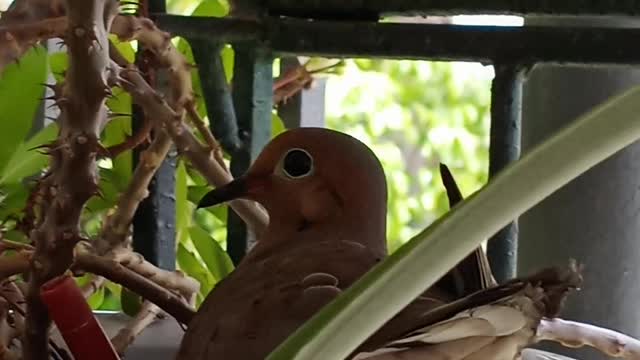Premium Only Content

A MOURNING DOVE NESTING IN A PLANT POT OF "CROWN OF THORNS"
The small-headed, dark-eyed, a-dark-patch-at-either-side-of-the-neck, slender-bodied, red-legged, tapered-tail, grayish-brown (some pale pinkish hue is sported down the neck towards the chest on adult males) mourning dove of sparsely dark-brown-spots-and-flecks dappled wing feathers is appropriately named due to its somber cooing sound that some people have mistaken to be the call of an owl. Be that as it may, in addition to its typical descriptive name, this bird of whistling wings, which is so abundant in the North American territories that it is a gamebird, has also been called in the past the Carolina pigeon as well as the rain dove and, unofficially, the turtledove, among other names.
Still on the matter of this bird species' variety of names, individuals who rightfully believe in the rightfulness of recognizing creatures and other phenomena of the Creation as being works of our shared Maker shall be, to whatever degree, peeved that the taxonomic designation Zenaida macroura is not simply representative of a tribute to Zénaïde Laetitia Julie Bonaparte, the royal cousin-spouse of famed 1800s French ornithologist Charles Lucien Bonaparte, but is in this element of its moniker referencing likewise the mythical Greek idol Zeus. Now, its second half, namely macroura, is benign, for all it really means is "long-tailed."
A noted monogamous avian species, a pair of mourning doves is capable of laying, incubating, and nurturing more than four broods of two white eggs in their breeding season, which certainly helps them to keep their numbers up in spite of being hunted by humans and also by animal predators such as daytime birds of prey, raccoons, opossums, snakes, and cats. And, with regard to parenting, admirably, the male aids the female in incubating and caring for their young, permitting the female to go off to eat and rest up for her next round of young care.
But, as far as where they choose to construct their minimalistic nests at times, such has attracted some quandary and frowning, for they have even been known to build their nests aground and lay their eggs in the same less than secure construction.
And, being not so wary of humans as to keep considerable distance, some may even set up temporary home and nursery in a plant pot, even as did this couple that decided to share the space of a Creme Supreme plant, a plant otherwise known as "Crown of Thorns," and that name being for obvious reasons.
To the spiritually minded, this featured likely one-in-a-million, perhaps even unprecedented, instance of peculiar nesting site could well symbolically bear a significant message, insofar as the dove is Biblically a symbol of "the Holy Spirit" (rf. Matthew 3:16, Mark 1:10, Luke 3:22, & John 1:32), and the plant's name reminds us of Christ Jesus in the midst of His sacrificial suffering to redeem and reconcile the repentant of humanity. (Consult Matthew 27:29 & John 19, particularly verses 2 & 5.)
Food for thought while this particular refuged dove family's members are not food for the plate.
SOURCES CONSULTED: Wikipedia on "mourning dove"; AZ Animals (https://a-z-animals.com/animals/mourning-dove/); Wild Bird Watching article "Mourning Dove Habits" (https://www.wild-bird-watching.com/Doves.html); Wikipedia on "Zénaïde Laetitia Julie Bonaparte" (https://en.m.wikipedia.org/wiki/Z%C3%A9na%C3%AFde_Bonaparte").
-
 LIVE
LIVE
SpartakusLIVE
6 hours ago$20,000 Hide and Seek Tourney w/ Stonemountain64 || #1 Rat wins the BIG CHEESE
353 watching -
 57:00
57:00
BEK TV
22 hours agoOpen Range
1.6K -
 1:06:27
1:06:27
BonginoReport
4 hours agoBig Bad JB Threatens Trump! - Nightly Scroll w/ Hayley Caronia (Ep.120) - 08/26/2025
95.4K40 -
 1:02:26
1:02:26
Kim Iversen
4 hours agoIran Rejects Nuclear ‘Spy’ Inspectors — War Next?
40.2K84 -

StoneMountain64
8 hours agoWARZONE LEGEND RETURNS. GHILLIE SUIT $20k TOURNEY.
60.8K3 -
 1:06:33
1:06:33
TheCrucible
4 hours agoThe Extravaganza! EP: 27 with Guest Host: Rob Noerr (8/26/25)
33.2K3 -

GloryJean
10 hours agoHide & Seek Tournament w/ Spartakus, StoneMountain64 & Stevie
20.8K -

Reidboyy
7 hours ago $0.20 earnedNEW FREE FPS OUT ON CONSOLE NOW! (Delta Force = BF6 with Killstreaks)
12.7K -
 1:37:26
1:37:26
Redacted News
5 hours agoHIGH ALERT! DID UKRAINE JUST DECLARE WAR ON HUNGARY? ZELENSKY DEMANDS MORE CASH FROM NATO | REDACTED
165K112 -
 7:14:43
7:14:43
Akademiks
7 hours agoDrake got finessed w/ Fake Chain? Drake vs hip hop media. Cardi B in court. Did Young thug SNITCH?
36.5K2